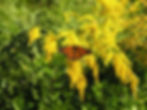
“Gardeners are acutely attuned to the crises our planet faces: We see the impacts of drought and intense storms firsthand. We notice when fewer monarchs or woodpeckers visit our yards. So it is no surprise that gardeners everywhere are looking for ways to garden more sustainably.” - Laura Fenton for Gardenista
Wherever you live, the experts all recommend planting native plants and ditching pesticides and other harmful chemicals.

Here are 7 ways that the professionals say you can help
1. Plant more “super plants.”
Super plants are plant species that support the broadest range of fauna possible. High performing plants on the east coast include mountain mints (Pycnanthemum sp), native asters (Symphiotrichum/Eurybia sp), goldenrods (Solidago sp), and spotted geranium (Geranium maculatum).
2. Get to know your growers.
Supporting local growers is environmentally sound and keeps money and jobs in your local community. Blue Water Baltimore’s Herring Run Nursery specializes in plants native to the Chesapeake Bay watershed.
3. Avoid neonics.
If you care about the environment, you’ve likely already banned the use of insecticides in your garden. Take it a step further: purchase only plants grown without insecticides. Pesticides like neonicotinoids work inside a plant, making the plant’s own tissue toxic for insects. Growers use them to keep plants pest-free in the nursery, but they can persist for years in plants and soils. The best way to avoid these toxins is to ask growers and retailers if the plants were grown without pesticides.

4. Become your own nursery.
This year, grow it yourself. In addition to propagating plants from cuttings or divisions, get into the habit of collecting seed from plants you’ve grown. You can replenish your stock for free and it will help you avoid the plastic pots that are standard fare in retail garden centers.
5. Opt for green mulch.
Replace traditional mulch with “green mulch” (aka “living mulch”), such as clonal spreading native groundcovers. Using ‘green mulch’ to cover bare ground around the base of your taller plants enriches the soil and suppresses weeds. Look for spring-flowering, shade-tolerant species that grow under other bigger plants.
6. Put down the leaf blower.
Leave leaves on the ground because they function as a temperature buffer, moisture regulator, and food and habitat for wildlife and soil organisms. The weekly practice of removing leaves from the garden with high-powered blowers literally blows away biodiversity and interferes with the natural processes necessary for a native garden to be ecological or biodiverse.

7. Consider other options than a large grassy yard.
Horticulturist Rebecca McMackin suggests that your lawn be more of an area rug rather than a wall to wall carpet. Maintaining grass lawns increases greenhouse gasses, pollutes ecosystems, wastes water, and diminishes biodiversity. Grass lawns are expensive, unsustainable, and poor investments. While more environmentally friendly than pavement, grass lawns and their upkeep come with heavy carbon costs. Lawn mowers, irrigation systems, and fertilizers add to households’ carbon footprint.
Instead consider one of the following:
Grown covers include sedum, creeping thyme, Corsican mint, and chamomile
Meadow lawns are composed of a variety of low-maintenance native plants that are interspersed with wildflower seeds or wildflower plugs.
Moss is a low-maintenance grass alternative that stays green all year long and requires no mowing, weeding, watering, or fertilization. It's ideal for landscapes that receive ample shade and moisture.
Herb gardens pull double duty as a low maintenance lawn alternative and a food source.
Source: Gardenista
